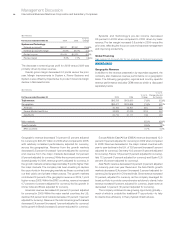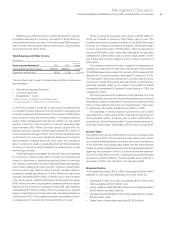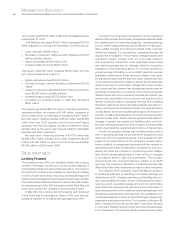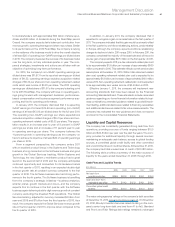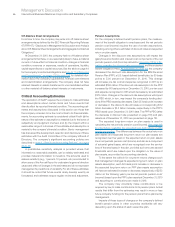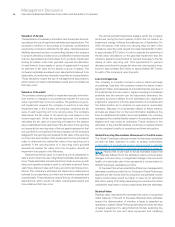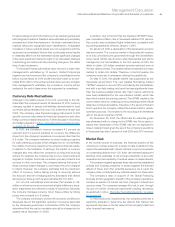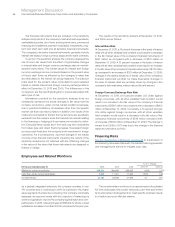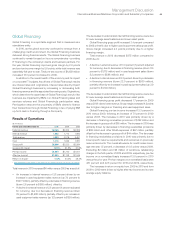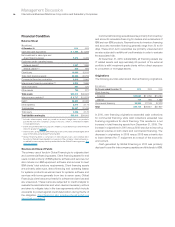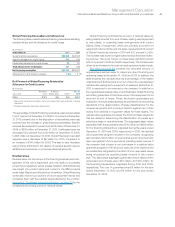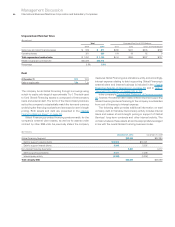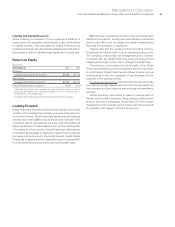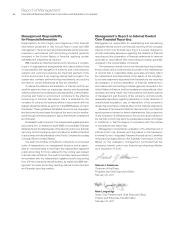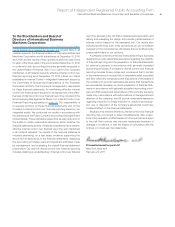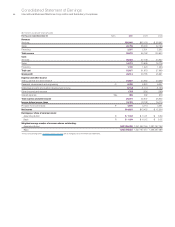IBM 2010 Annual Report Download - page 55
Download and view the complete annual report
Please find page 55 of the 2010 IBM annual report below. You can navigate through the pages in the report by either clicking on the pages listed below, or by using the keyword search tool below to find specific information within the annual report.
53
Management Discussion
International Business Machines Corporation and Subsidiary Companies
forward-looking product information such as marketing plans and
technological innovations. Residual value estimates are periodically
reviewed and “other than temporary” declines in estimated future
residual values are recognized upon identification. Anticipated
increases in future residual values are not recognized until the
equipment is remarketed. Factors that could cause actual results
to materially differ from the estimates include significant changes
in the used-equipment market brought on by unforeseen changes
in technology innovations and any resulting changes in the useful
lives of used equipment.
To the extent that actual residual value recovery is lower than
management’s estimates by 10 percent, Global Financing’s
segment pre-tax income and the company’s consolidated income
before income taxes for 2010 would have been lower by an esti-
mated $120 million. If the actual residual value recovery is higher
than management’s estimates, the increase in income will be
realized at the end of lease when the equipment is remarketed.
Currency Rate Fluctuations
Changes in the relative values of non-U.S. currencies to the U.S.
dollar affect the company’s results. At December 31, 2010, currency
changes resulted in assets and liabilities denominated in local
currencies being translated into more U.S. dollars than at year-end
2009. The company uses financial hedging instruments to limit
specific currency risks related to financing transactions and other
foreign currency-based transactions. Further discussion of currency
and hedging appears in note L, “Derivative Financial Instruments,”
on pages 96 through 101.
In 2010, the company’s revenue increased 4.3 percent as
reported and 3.3 percent adjusted for currency, the difference
driven from the company’s operations in currencies other than the
U.S. dollar. The company maintains currency hedging programs
for cash planning purposes which mitigate, but do not eliminate,
the volatility of currency impacts on the company’s financial results.
In addition to the translation of earnings, the impact of currency
changes also may affect the company’s pricing and sourcing
actions. For example, the company may procure components and
supplies in multiple functional currencies and sell products and
services in other currencies. The company believes that some of
these currency-based changes in cost impact the price charged
to clients. However, the company estimates that the maximum
effect of currency, before taking pricing or sourcing actions
into account, and net of hedging activity, decreased total diluted
earnings per share growth by approximately $0.11 in 2010.
For non-U.S. subsidiaries and branches that operate in U.S.
dollars or whose economic environment is highly inflationary, trans-
lation adjustments are reflected in results of operations. Generally,
the company manages currency risk in these entities by linking
prices and contracts to U.S. dollars.
The company continues to monitor the economic conditions in
Venezuela. Due to the significant reduction of currency approvals
by the Venezuela government, in December 2009, the company
determined that the rate for translation should be changed to the
parallel rate at December 31, 2009.
In addition, due to the fact that the blended CPI/NCPI three-
year cumulative inflation rate in Venezuela reached 100 percent,
the country was considered highly inflationary, consistent with
accounting standards, effective January 1, 2010.
On January 8, 2010, a devaluation of the Venezuelan currency
was announced. The currency market in Venezuela will continue
to be fully controlled by the government through the Central Bank.
A two-tiered official rate structure was implemented and will be
managed by the Central Bank. In the first quarter of 2010, the
ability to obtain U.S. dollars remained severely restricted, even at
the new devalued rates. The parallel market remained the primary
method to obtain U.S. dollars. Therefore, in the first quarter, the
company continued to remeasure utilizing the parallel rate.
On May 17, 2010, the parallel market was suspended by the
Venezuela government. The new parallel fluctuating market
(“SITME”) opened on June 9, 2010, controlled by the Central Bank,
and with a set daily trading rate band that was significantly lower
than the previous parallel market rate. Tight volume restrictions
have been established for the new banded market, which has
been thinly traded since being opened. The SITME market is the
current viable option for obtaining currency exchange as the official
rates have not been accessible. Therefore, in the second, third and
fourth quarters, the company utilized the banded rate for remea-
surement purposes. This resulted in the recording of an immaterial
gain in the second quarter of 2010.
On December 30, 2010, the official rate for essential goods
was eliminated, with no change to the SITME rate. Future gains or
losses from devaluation of the SITME rate are not expected to
have a material impact given the size of the company’s operations
in Venezuela (less than 1 percent of total 2009 and 2010 revenue).
Market Risk
In the normal course of business, the financial position of the
company is routinely subject to a variety of risks. In addition to the
market risk associated with interest rate and currency movements
on outstanding debt and non-U.S. dollar denominated assets and
liabilities, other examples of risk include collectibility of accounts
receivable and recoverability of residual values on leased assets.
The company regularly assesses these risks and has established
policies and business practices to protect against the adverse
effects of these and other potential exposures. As a result, the
company does not anticipate any material losses from these risks.
The company’s debt, in support of the Global Financing
business and the geographic breadth of the company’s operations,
contains an element of market risk from changes in interest and
currency rates. The company manages this risk, in part, through
the use of a variety of financial instruments including derivatives,
as explained in note L, “Derivative Financial Instruments,” on pages
96 through 101.
To meet disclosure requirements, the company performs a
sensitivity analysis to determine the effects that market risk
exposures may have on the fair values of the company’s debt and
other financial instruments.



